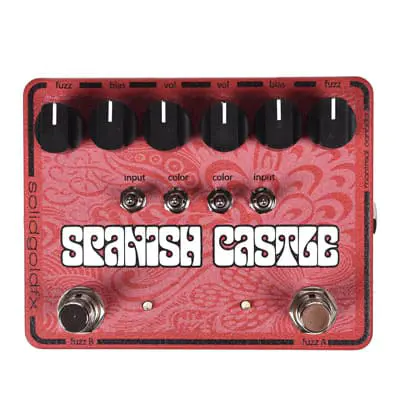
Noise seekers who aren’t quite satisfied with one fuzz at a time should take a look at the brand new SolidGoldFX Spanish Castle.
Hailing from beautiful Montreal, this Canadian manufacturer has been stepping up its game in the last year or so with new products that marry great tone with plenty of flexibility, while sporting circuits often dedicated to specific musical eras; for example, SolidGoldFX states that the Spanish Castle is inspired by year 1969…
…a turning point in the gear world: it was the year that Dallas-Arbiter switched Fuzz Face production from the lower-gain germanium transistor core to readily available higher-gain silicon devices.
The pedal features two of the company’s If 6 Was 9 circuits. The fuzzes are independent from each other and have dedicated knobs, toggles and footswitches. You can play them one at a time (they are slightly different) or stack them on top of each other. The right-side fuzz is first in the chain and has a warmer voice, “with low-gain silicon transistors that emulate the rich character of germanium with more stable and consistent operation.” The second one, on the left side, offers instead “higher-gain silicon transistors for a more buzzsaw-like grind, metal film resistors for tighter tolerances and an extended bias range for dialing in ripping gated fuzz textures as well as full-bodied snarl.”
The toggle switches offer extra flexibility, with Color behaving like a 3 way low pass filter to tame highs and high-mids, and Input changing gain and bass values to tailor the pedal to rigs that include a wah and other finicky pedals.
The Spanish Castle also features an under the hood switch that changes between:
Bold and Comp modes the former increasing the output and midrange, and the latter offering a softer, more compressed tone.
Check out the Mike Hermans and Tone Report demos:
The year 1969: Not only was Led Zeppelin’s eponymous album released, but Woodstock took place in August. 1969 marks a turning point in the gear world also; it was the year that Dallas-Arbiter switched Fuzz Face production from the lower-gain germanium transistor core to readily available higher-gain silicon devices. Our Spanish Castle pays tribute to this year.
Packed to the turrets with fuzz spread across two separate and footswitchable If 6 Was 9 circuits, the Spanish Castle is the perfect device for the fuzz-crazy and fuzz-curious alike. Combining both Fuzz Face eras with a little contemporary magic is what we do around here.
The right side of the Spanish Castle represents the warmer pre-’69 circuit and is equipped with low-gain silicon transistors that emulate the rich character of germanium with more stable and consistent operation. Carbon-composition resistors further round everything out for a sound that is just like they used to roll them off the line. Unlike the Faces of yore, this circuit is equipped with a bias circuit to dial in just the right flavor, and cleans up like a champ. The original tenant of the Spanish Castle would have loved it.
On the left side, our post-’69 If 6 Was 9 circuit lies in wait. This wing of the Spanish Castle offers up higher-gain silicon transistors for a more buzzsaw-like grind, metal film resistors for tighter tolerances and an extended bias range for dialing in ripping gated fuzz textures as well as full-bodied snarl.
Each side offers up two toggle switches—Color is a three-position switch that adjusts the EQ of its respective side, from flat EQ to two settings that shave off treble and mids. The Input toggle is also a three-position switch, changing gain and bass values that make the Spanish Castle adapt better to your wahs and other pedals.
If that’s not enough control for you, each side contains an internal switch that changes between Bold and Comp modes, the former increasing the output and midrange, and the latter offering a softer, more compressed tone.
Please enjoy your stay in the Spanish Castle. You’d better make yourself at home. You’re going to be here a while.






















